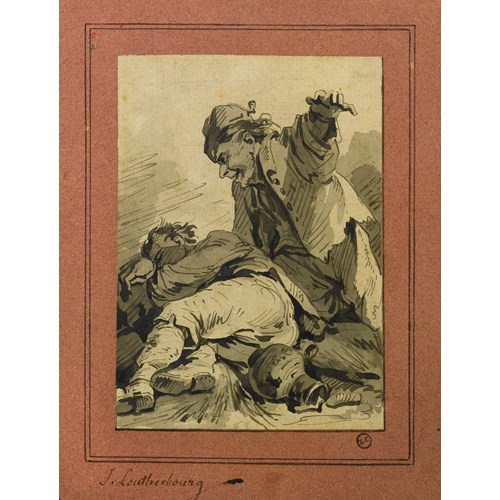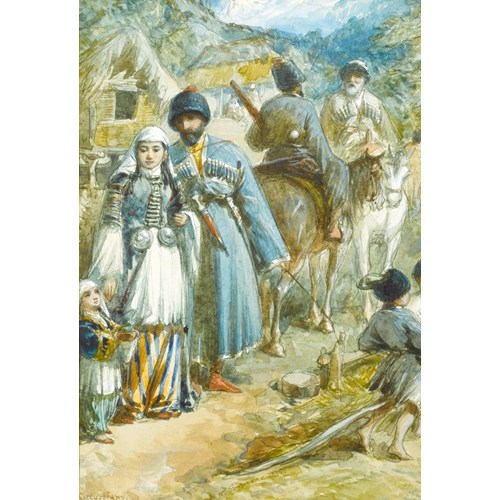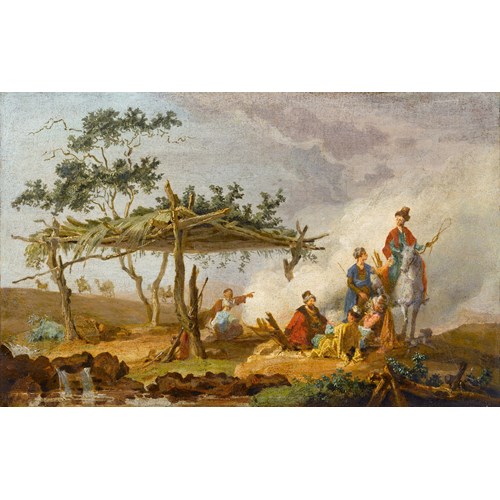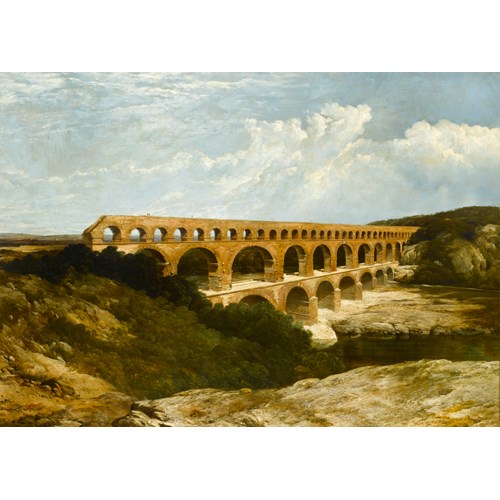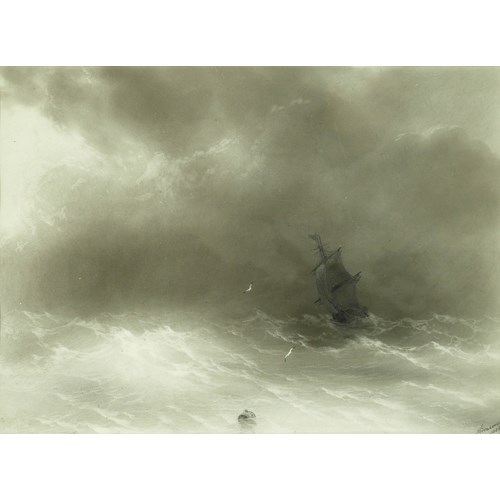Marketplace
Taking the Horses to Water
Julius von Blaas
Taking the Horses to Water
Period 1850-1900, 19th century, 20th century
Origin Austria
Medium Oil on panel
Dimension 38 x 63 cm (15 x 24³/₄ inches)
On a hot summer day, a farm is abuzz with activity during the annual hay making season. It is threshing day, and a multitude of horses and carts are being used to move the yield to and from the thresher. In the foreground we see several of these animals being queued up, for their well earned refreshment. Two troughs, hollowed from tree trunks, have been set up near the shadoof, from which water can be easily provided for the thirsty horses. In the background we see farm labourers loading the mounds of hay into the mechanical thresher, which is powered by the black bulk of the steam engine nearby. Julius von Blaas skilfully conveys the oppressive heat, in which the people and animals must work, through a number of techniques, including the sheen of sweat shimmering on the horses’ flanks, the glare which radiates from the landscape and the clear blue sky, and the slightly parched and dried look of the grass in the foreground.
The present work provides a fascinating insight into agricultural practises in Austro-Hungary during the latter part of the nineteenth century. According to Giovanni Federico, ‘In Hungary the first steam-thresher was imported in 1854, and the number rose...to 8,920 in 1895 - plus some 46,800 horse driven machines’.¹ Von Blaas, therefore, has depicted what would have been a relatively unusual and modern machine, even taking into account that these machines ‘were often shared or rented’.² This depiction creates an effective contrast with the shadoof, looming over the foreground, the origins of which can be traced to ancient Mesopotamia, although they were still in common use in Austro-Hungary during von Blaas’ time. The threshers were renowned for requiring a large amount of man power, and as a result threshing days tended to be large events, bringing together a community, and this is reflected in the present work.
Von Blaas was taught by his father Carl von Blaas (1815-1894) and trained in Venice, Florence and Rome. He was also influenced by his celebrated brother Eugen von Blaas (1843-1931). Von Blaas was a prolific equestrian painter, although his subject matter was wide-ranging within this genre. In paintings such as the present one, or Horse and Cart at the Well, (Private Collection) he explores the central role horses played in the lives of rural peasants. In Horse and Cart at the Well von Blaas actually uses the same central motif of wooden trough and shadoof, which is so evident in the present work. In addition to his scenes of rural life, von Blaas also painted many equestrian portraits and hunting scenes, and in all his work his technical mastery of equine painting is evident.
¹ Federico, G. ‘Steam Threshing in Nineteenth Century Italy’ in Advances in Agricultural Economic History, Volume 2, ed. Kauffman, K. D. (Elsevier Science, Oxford, 2003), p. 100.
² Ibid. p. 99.
The present work provides a fascinating insight into agricultural practises in Austro-Hungary during the latter part of the nineteenth century. According to Giovanni Federico, ‘In Hungary the first steam-thresher was imported in 1854, and the number rose...to 8,920 in 1895 - plus some 46,800 horse driven machines’.¹ Von Blaas, therefore, has depicted what would have been a relatively unusual and modern machine, even taking into account that these machines ‘were often shared or rented’.² This depiction creates an effective contrast with the shadoof, looming over the foreground, the origins of which can be traced to ancient Mesopotamia, although they were still in common use in Austro-Hungary during von Blaas’ time. The threshers were renowned for requiring a large amount of man power, and as a result threshing days tended to be large events, bringing together a community, and this is reflected in the present work.
Von Blaas was taught by his father Carl von Blaas (1815-1894) and trained in Venice, Florence and Rome. He was also influenced by his celebrated brother Eugen von Blaas (1843-1931). Von Blaas was a prolific equestrian painter, although his subject matter was wide-ranging within this genre. In paintings such as the present one, or Horse and Cart at the Well, (Private Collection) he explores the central role horses played in the lives of rural peasants. In Horse and Cart at the Well von Blaas actually uses the same central motif of wooden trough and shadoof, which is so evident in the present work. In addition to his scenes of rural life, von Blaas also painted many equestrian portraits and hunting scenes, and in all his work his technical mastery of equine painting is evident.
¹ Federico, G. ‘Steam Threshing in Nineteenth Century Italy’ in Advances in Agricultural Economic History, Volume 2, ed. Kauffman, K. D. (Elsevier Science, Oxford, 2003), p. 100.
² Ibid. p. 99.
Period: 1850-1900, 19th century, 20th century
Origin: Austria
Medium: Oil on panel
Signature: Signed Julius von Blaas lower left
Dimension: 38 x 63 cm (15 x 24³/₄ inches)
Provenance: Acquired by the father-in-law of the previous owner circa 1910;
thence by descent to the previous Swiss collector.
More artworks from the Gallery




